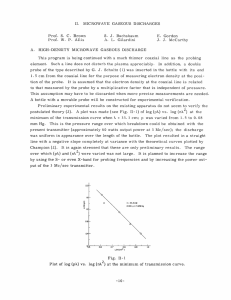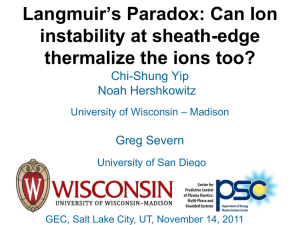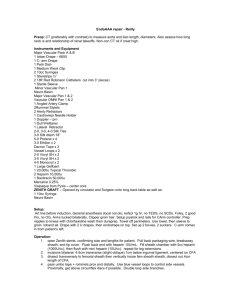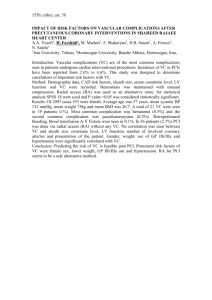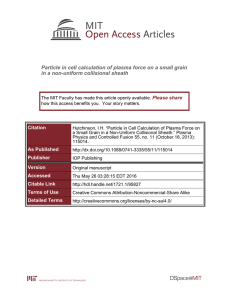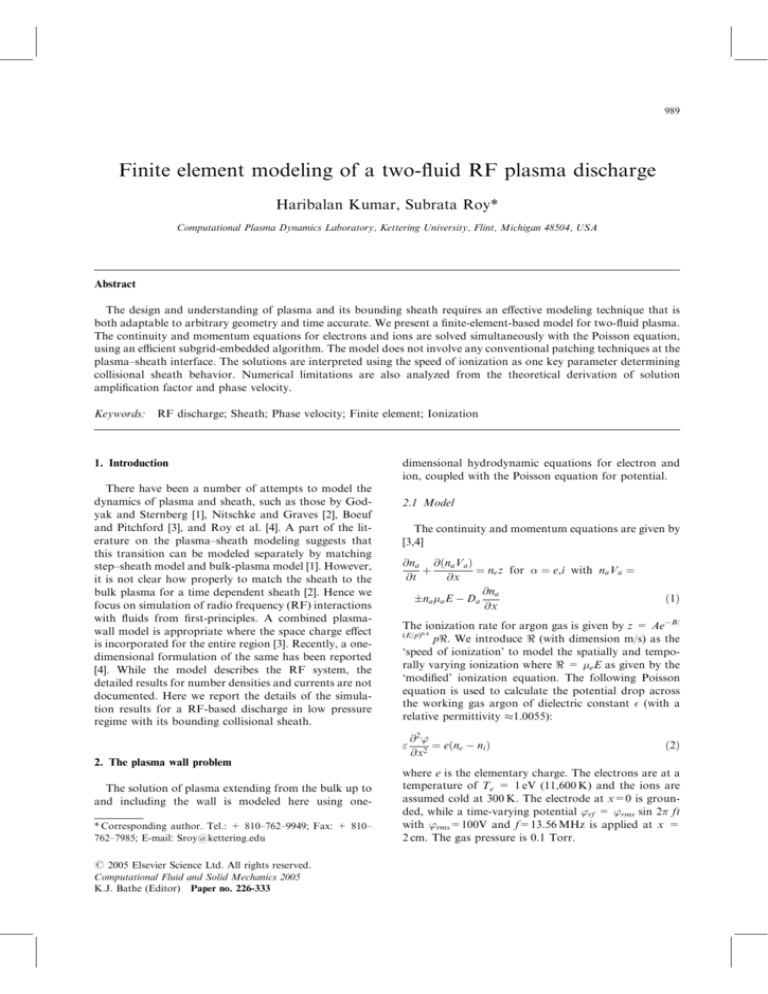
989
Finite element modeling of a two-fluid RF plasma discharge
Haribalan Kumar, Subrata Roy*
Computational Plasma Dynamics Laboratory, Kettering University, Flint, Michigan 48504, USA
Abstract
The design and understanding of plasma and its bounding sheath requires an effective modeling technique that is
both adaptable to arbitrary geometry and time accurate. We present a finite-element-based model for two-fluid plasma.
The continuity and momentum equations for electrons and ions are solved simultaneously with the Poisson equation,
using an efficient subgrid-embedded algorithm. The model does not involve any conventional patching techniques at the
plasma–sheath interface. The solutions are interpreted using the speed of ionization as one key parameter determining
collisional sheath behavior. Numerical limitations are also analyzed from the theoretical derivation of solution
amplification factor and phase velocity.
Keywords:
RF discharge; Sheath; Phase velocity; Finite element; Ionization
1. Introduction
There have been a number of attempts to model the
dynamics of plasma and sheath, such as those by Godyak and Sternberg [1], Nitschke and Graves [2], Boeuf
and Pitchford [3], and Roy et al. [4]. A part of the literature on the plasma–sheath modeling suggests that
this transition can be modeled separately by matching
step–sheath model and bulk-plasma model [1]. However,
it is not clear how properly to match the sheath to the
bulk plasma for a time dependent sheath [2]. Hence we
focus on simulation of radio frequency (RF) interactions
with fluids from first-principles. A combined plasmawall model is appropriate where the space charge effect
is incorporated for the entire region [3]. Recently, a onedimensional formulation of the same has been reported
[4]. While the model describes the RF system, the
detailed results for number densities and currents are not
documented. Here we report the details of the simulation results for a RF-based discharge in low pressure
regime with its bounding collisional sheath.
dimensional hydrodynamic equations for electron and
ion, coupled with the Poisson equation for potential.
2.1 Model
The continuity and momentum equations are given by
[3,4]
@na @ðna Va Þ
þ
¼ ne z for ¼ e,i with na Va ¼
@t
@x
@na
na a E Da
@x
ð1Þ
The ionization rate for argon gas is given by z = AeB/
(E/p)0.4
p<. We introduce < (with dimension m/s) as the
‘speed of ionization’ to model the spatially and temporally varying ionization where < = eE as given by the
‘modified’ ionization equation. The following Poisson
equation is used to calculate the potential drop across
the working gas argon of dielectric constant (with a
relative permittivity 1.0055):
"
@2’
¼ eðne ni Þ
@x2
ð2Þ
2. The plasma wall problem
The solution of plasma extending from the bulk up to
and including the wall is modeled here using one* Corresponding author. Tel.: + 810–762–9949; Fax: + 810–
762–7985; E-mail: Sroy@kettering.edu
# 2005 Elsevier Science Ltd. All rights reserved.
Computational Fluid and Solid Mechanics 2005
K.J. Bathe (Editor) Paper no. 226-333
where e is the elementary charge. The electrons are at a
temperature of Te = 1 eV (11,600 K) and the ions are
assumed cold at 300 K. The electrode at x=0 is grounded, while a time-varying potential ’rf = ’rms sin 2
ft
with ’rms=100V and f=13.56 MHz is applied at x =
2 cm. The gas pressure is 0.1 Torr.
990
H. Kumar, S. Ray / Third MIT Conference on Computational Fluid and Solid Mechanics
2.2 Boundary conditions
The problem is considered in its entirety without
imposing any conditions at plasma edge for solving the
bounding sheath. The sheath edge is identified and Vi/
VB = [1 + ]0.5 is the ion sonic for the collision
parameter = 0.5
D/i where D is the Debye length,
the effective ion mean free path i(cm) 1/330P (in torr),
and VB is the ion sonic (Bohm) velocity.
The electron flux at the electrodes is based on the
thermalized electron velocity whose magnitude is given
by Ie = neVe,th. Homogeneous Neumann boundary
condition (@ni/@ z=0) is applied for ions at electrodes.
For the Poisson equation we used ’(0) = 0 and ’(2) =
’c where ’c is calculated from the following current
balance
Itot ðtÞ ¼ "
@E
þ eni Vi ene Ve
@t
ð3Þ
The equations (1)–(3) are normalized using the following
dimensionless quantities, = 2
ft, z = x/d, S = zd/VB,
N = n/n0, u=V/VB and = e’/Te where d is interelectrode length.
where F is the solution residual, and the GWS form of
Eq. (2) with residual F is
0
Z
Z
d T
d d T
B
dxfge þ
dxfge þ
Se @
dx dx
dx
Z
e
@e
T dxfNe ge Z
e
T dxfNi ge Þe ¼ F
ð5Þ
e
The terminal non-linear ordinary differential equation
(ODE) systems derived from Eqs. (4)–(5) are solved
using implicit Euler method and N-R iterative algorithm. The domain is discretized into 200 elements and
is interpolated using a linear basis function. The Jacobian matrix J = [@F/@Q] in [J].{@Q} = {F} is resolved
using LU-decomposition scheme for updating change in
discretized solution vector Q at each iteration. The
convergence criterion for all variables at any iteration is
103.
3.2 Amplification factor and phase velocity
The stability of the above algorithm in section 3.1 can
be investigated from the solution amplification factor
Gh, its magnitude jGhj and the relative phase velocity h.
For example, based on the finite element stencil for Eq.
(4) one may derive the following factors for ions:
3. Numerical methodology
We utilized multiscale ionized gas (MIG) flow code
anchored in a powerful high-fidelity finite-element procedure that has been benchmarked and validated against
a range of plasma wall problems [5,6]. Here the methodology is adopted to overcome the stiffness of the
above system of equations, Eqs. (1)–(3).
Gh ¼ ½1 3iCfð!xÞ Stðcos þ i sin Þ1
ð6Þ
0:5
h G ¼ ð1 St cos Þ2 þ ð3Cfð!xÞ þ St sin Þ2
h
1 ð3Cfð!xÞ þ St sin Þ
C!x
ð7Þ
¼ tan
ð1 St cos Þ
3.1 Galerkin weak statement (GWS)
while those for electrons are:
For the stated RF bounded plasma discharge, the
equation set can be written with operator L, as L(q) = 0
where q = {Ni, Ne, }T. Multiplying with a permissible
test function and integrating over the spatially discretized solution domain , the variational statement
!
R
h
results in the weak form WS ¼ Se
½LðqÞd ¼ 0
e
e
for a discretization h of domain = [e and Se is the
non-overlapping sum over the elements. Thus the GWS
form of Eq. (1) becomes
8
0
>
Z
<Z
dfN
g
B
e
þ
Se @ T dx
ð ÞT dxfN ge >
dt
:
e
Z
e
d
ð ÞT dxfN ge
dx
@e
)
Z
e
T dxfNe ge Þe ¼ F
ð4Þ
Gh ¼ ½1 3iCfð!xÞ St1 ;
h
G ¼ ½ð1 StÞ2 þ ð3Cfð!xÞÞ2
3Cfð!xÞ
h ¼ tan1
C!x
ð1 StÞ
ð8Þ
ð9Þ
where ! is the wave number, x is the length of an
element, C is the Courant number, fð!xÞ ¼ sin !x=
ð2 þ cos !xÞ and ¼ ðuhe uhi Þ!ðn þ 1Þt is the
relative velocity phase angle.
The algorithm is stable if jGhj 1. One prefers h 1
to minimize the loss of information during solution
process. Figure 1 plots jGhj and h as functions of !x
and C for = 0 (hence true for both ions and electrons).
Obviously, for the higher value of ionization rate S2 =
500, the solution becomes unstable. The numerical difficulty may be handled by the appropriate selection of
Courant number and the introduction of artificial
H. Kumar, S. Ray / Third MIT Conference on Computational Fluid and Solid Mechanics
991
Fig. 1. Amplification factor (jGhj) and relative phase velocity (h) for different Courant numbers (CFL), and ionization rates S1 = 5
and S2 = 500.
Fig. 2. Temporal evolution of normalized electron number
density (Ne).
Fig. 3. Periodic nature of the potential and normalized total
current at the powered electrode.
and Cf (!x) that will be elaborated in an ensuing
paper.
4. Results and discussions
Fig. 4. Temporal oscillation of left (SL) and right (1-SR) normalized sheath width.
diffusion. Interestingly, any further increase of S (>
500) brings the system back to stability (not shown in
the fig.). This demonstrates a nice balance between St
Figures 2–4 describe the computed solution using the
methodology stated above. The momentary rise of the
electron wave at the alternate electrodes in Fig. 2 at
every /2 and 3
/2 radians shows a typical RF characteristic. For most of the remaining time, the chargeseparated sheath region is mostly devoid of electrons.
Fig. 3 shows the variation of total current as given by
Eq. (3) with the computed potential. The periodicity of
the peak total current is observed near (
/2 + 2p
)
radian; p 0 is an integer.
Finally, Fig. 4 plots the sheath edge as identified in
section 2.2. The difference in normalized sheath thickness at the grounded left electrode (SL) and the powered
right electrode (1-SR) shows an expected 2
periodicity
between the points of extremum sheath locations with a
992
H. Kumar, S. Ray / Third MIT Conference on Computational Fluid and Solid Mechanics
phase lag of radian for the left electrode. An
approximate relation for left and right side normalized
sheath thickness can be estimated as S 0.04 0.03 sin
2
ft with an error of 4%.
In summary, we developed a two-fluid algorithm for
predicting RF discharges and successfully demonstrated
its implementation into the MIG code. Results for the
charge distributions, current, and sheath details have
been documented. In the future, the model will be
extended for analyzing two-dimensional RF plasma
discharge.
References
[1] Godyak V, Sternberg N. Dynamic model of the electrode
sheaths in symmetrically driven RF discharges. Physical
Review A 1990;42(4):2299–2312.
[2] Nitschke TE, Graves DB. A comparison of particle-in-cell
and fluid model simulations of low pressure radio frequency discharges. J of Applied Physics 1994;
76(10):5646–5660.
[3] Boeuf JP, Pitchford LC. Two-dimensional model of a
capacitively coupled RF discharge and comparisons with
experiments in the Gaseous Electronics Conference reference reactor. Physical Review E 1995;51(2):1376–1390.
[4] Roy S, Pandey BP, Poggie J, Gaitonde D. Modeling low
pressure collisional plasma sheath with space-charge
effect. Physics of Plasmas 2003;10(6):2578–2585.
[5] Roy S, Gaitonde D. Radio frequency induced ionized
collisional flow model for application at atmospheric
pressures. J of Applied Physics 2004;96(5):2476–2481.
[6] Roy S, Pandey BP. Development of a finite element based
Hall thruster model. J of Propulsion and Power
2003;19(5):964–971.

